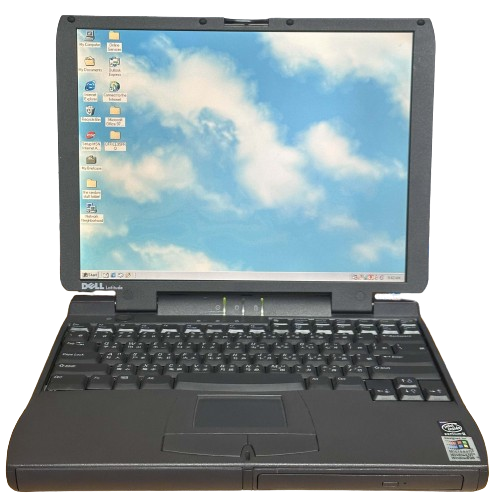
Dell Latitude CPi
The Latitude CPi is a Pentium II-based laptop, initially released by Dell in 1998 and sold through 1999. The initial CPis shared the same case as the 1997 Latitude CP, while later models changed the design up a bit.
Sub-Series ID
The Latitude CPi had three different sub-series, those being the D, A, and R series.
The easiest way to identify your CPi's series is to check the model number shown on the BIOS loading screen. The letter that the model number begins with is the series of your CPi. (Example: D233ST would be a D series). The series may also be printed on the bottom sticker.
Visual Identification
If you are looking at a listing of one online that doesn't show a photo of the bottom sticker or a photo of the BIOS, it can be useful to be able to tell the three apart by looks alone. Luckily, this is easy.
- D Series - Bottom left and right corners of the display housing are curved.
- A Series - Bottom left and right corners of the display housing are sharp.
- R Series - Display housing design differs significantly and looks more similar to a CPx than the other two CPis.
With this info, you should be able to tell that the CPi on this page is a D-Series.
Specifications
| Spec | CPi-D Series | CPi-A Series | CPi-R Series |
|---|---|---|---|
| Sub-Models | D233ST, D266ST, D266XT, D300XT | A366ST, A366XT, A400XT | R400GT |
| CPU | Intel Mobile Pentium II @233, 266, or 300MHz | Intel Mobile Pentium II @366 or 400MHz | Intel Mobile Pentium II @400MHz |
| RAM | 2x 144pin EDO slots - Up to 256MB Supported |
2x SDRAM slots - Up to 256MB(?) Supported |
2x SDRAM slots |
| Hard Disk | IDE 2.5" - Uses proprietary adapter |
||
| Display Options | - 12.1" Active Matrix Color LCD @800x600 - 13.3" Active Matrix Color LCD @1024x768 |
- 14.1" Active Matrix Color LCD @1024x768 | |
| Graphics Chipset | NeoMagic MagicGraph 128XD (NM2160) | NeoMagic MagicMedia 256AV (NM2200) | NeoMagic MagicMedia 256ZX (NM2360) |
| Audio | Crystal 4237B | NeoMagic NM2200 Audio | NeoMagic NM2360 Audio |
| Main Battery | Lithium Ion | ||
| CMOS Battery | Varta 6-cell NiMH | ||
| Power Supply | Latitude C-Series 3-pin proprietary - Dell PA-6 Family |
||
| Disk Drives | Latitude C-Series Modular Bay | ||
| Expansion | 2x PCMCIA/CardBus slots | ||
| Networking | None built-in | ||
| Other I/O | - 1x Parallel - 1x Serial - 1x VGA Out - 1x S-Video Out - 1x USB 1.x - 1x Mic In - 1x Headphone Out - 1x Line In - 1x Docking connector - 1x PS/2 |
||
| BIOS | Dell BIOS (Phoenix-based) | ||
| Pointing Device | Trackpad | ||
Resources
 Drivers (CPi-D) |
 Drivers (CPi-A) |
 Drivers (CPi-R) |
 User Manual (CPi-A) |
 Service Manual (CPi-D) |
 Service Manual (CPi-A) |
 Service Manual (CPi-R) |
|---|
Common Faults & Maintenance
Brittle Plastic
Plastic becoming brittle over time is a reality that affects just about every single laptop from the 1990s at this point. However, whatever plastic Dell used for the CPi appears to be exceptionally bad from my experience. The most common place to see cracks is around the display hinges, as is expected. Cracks on the 13.3" CPi-D and CPi-A laptops are inevitable. The 12.1" models seem to be more resistant, but I have seen a couple that were cracking. The 14.1" CPi-R laptops seem to be ok. Being somewhat based on the later CPx, the CPi-R laptops may have better plastic. I don't own one, so I can't say.
My advice would honestly just be to avoid the 13.3" laptops. I've taken them apart and there just doesn't seem to be a good way to prevent this cracking issue from happening.
CMOS Battery Leaks
The CPi's CMOS battery is a 6-cell VARTA NiMH rechargeable pack, located under the palmrest behind the left battery bay in the CPi-D and CPi-A laptops. The CPi-R also has one, but it may be in a slightly different place. Point is, these batteries leak close to 100% of the time, and while not located directly over the motherboard (in the CPi-D and CPi-A at least), they will still kill the board if left to rot long enough. The keyboard is probably the more pressing concern honestly, it's closer to the battery than the motherboard is. Get them out now!
Gallery
Coming soon.
Page last updated (MM/DD/YYYY): 08/01/2024
Update Reason: pages consolidated
Back-Navigation
Home < Laptop Portal < Dell < Latitude CPi